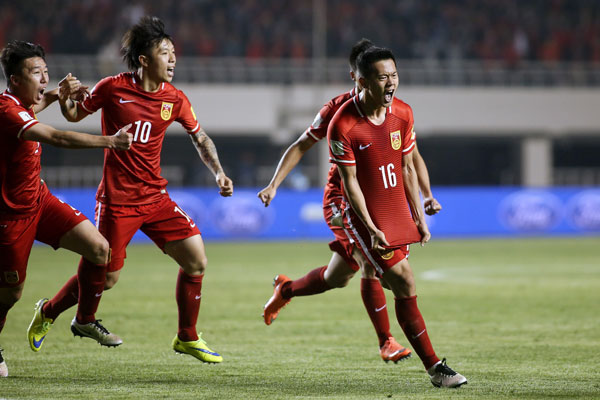Soccer in China gets a good plan at last
Updated: 2016-04-26 07:42
By Lei Lei(China Daily)
|
||||||||
 |
|
Playmaker Huang Bowen (right) opens the scoring in the 58th minute against Qatar on March 29, 2016. [Photo by Wu Zhizhao/For China Daily] |
While China is still struggling to qualify for the 2018 Football World Cup, it has set an ambitious goal to become a dominant soccer power in Asia by 2030 and a leading soccer power in the world by 2050.
The long-term goal was announced by the National Development and Reform Commission, China's top planning body, early this month. Although some soccer fans doubt whether the goal can be realized, the State-level policy for the uplift of soccer in the country is a welcome move. In fact, such plans have also been taken by traditional soccer powers in Asia, such as Japan and South Korea, and superpowers like Brazil and Germany.
In 2013, the South Korea soccer association set a goal to be among the top-10 world soccer powers by 2033, promising to raise the annual budget to 300 billion won ($270 million) to support the ambitious plan. South Korea also hopes to increase the number of soccer players in the country to 10 million by then. Benefiting from the policy, the South Korean national team now plays more friendlies with the world's top teams and has won the right to host the 2017 Under-20 World Cup.
Japan's soccer reform started in 1991. Through decades of efforts, Japan, which has played in the World Cup finals four times in the past 20 years, has got a complete and multi-tiered soccer league. It has more than 28,000 soccer teams at different levels and a total of 4.8 million soccer players, equal to those in four-time World Cup winner Italy.
The English soccer authority started a new program for grassroots soccer last year, and plans to invest £250 million ($360 million) to build more fields and train more coaches.
The rejuvenation of soccer in Germany, too, started with a reform. From 2001-02, soccer clubs in Germany started setting up training schools for children across the country, which drew the young generation back to the soccer field. Such was the impact of the plan that Germany regained the top ranking in the soccer world after winning the World Cup in 2014.
After being beaten 1-7 by Germany in the semi-finals of the 2014 World Cup, the host Brazil increased its investment in the youth training program. And last year, the soccer-crazy South American country set up a new national training center for talented youngsters.
Learning from the experiences of these soccer giants, China too has chosen to move on reform track-beginning with youths.
According to its short-term (2016-20) plan, China will establish a three-tier amateur competition system that will include grassroots club teams in 100 cities, and could involve more than 50 million participants. About 70,000 soccer fields are expected to be built and the number of schools specializing in soccer training is likely to increase from 8,000 to 20,000.
With State-level policy support, Chinese soccer is expected to form a virtuous circle like those in Western and South American countries.
Today, if a boy in England wants to play soccer, his parents have to just visit the official website of the English soccer authority, the Football Association, and type in their address to get detailed information on a center providing free soccer course close to their home.
To test the effectiveness of China's reform, a good criterion may be to check after a decade or so whether a Chinese youth can find a soccer training center as easily as his English peer.
The author is an editor with China Daily. leilei@chinadaily.com.cn
- Country's first soccer academy to train coaches
- Nation sets 2050 goal for soccer turnaround
- China to become soccer powerhouse by 2050
- The overall development plan of Chinese soccer
- Chinese soccer aims to be among world top teams by 2050
- Goal of becoming a soccer powerhouse rests with youth
- Teenage soccer, hockey players meet special fan
- Global health entering new era: WHO chief
- Brazil's planning minister steps aside after recordings revelation
- Vietnam, US adopt joint statement on advancing comprehensive partnership
- European border closures 'inhumane': UN refugee agency
- Japan's foreign minister calls A-bombings extremely regrettable
- Fukushima impact unprecedented for oceans: US expert

 Stars of Lijiang River: Elderly brothers with white beards
Stars of Lijiang River: Elderly brothers with white beards
 Wealthy Chinese children paying money to learn British manners
Wealthy Chinese children paying money to learn British manners
 Military-style wedding: Fighter jets, grooms in dashing uniforms
Military-style wedding: Fighter jets, grooms in dashing uniforms
 Striking photos around the world: May 16 - May 22
Striking photos around the world: May 16 - May 22
 Robots help elderly in nursing home in east China
Robots help elderly in nursing home in east China
 Hanging in the air: Chongqing holds rescue drill
Hanging in the air: Chongqing holds rescue drill
 2.1-ton tofu finishes in two hours in central China
2.1-ton tofu finishes in two hours in central China
 Six things you may not know about Grain Buds
Six things you may not know about Grain Buds
Most Viewed
Editor's Picks

|

|

|

|

|

|
Today's Top News
Liang avoids jail in shooting death
China's finance minister addresses ratings downgrade
Duke alumni visit Chinese Embassy
Marriott unlikely to top Anbang offer for Starwood: Observers
Chinese biopharma debuts on Nasdaq
What ends Jeb Bush's White House hopes
Investigation for Nicolas's campaign
Will US-ASEAN meeting be good for region?
US Weekly

|

|








